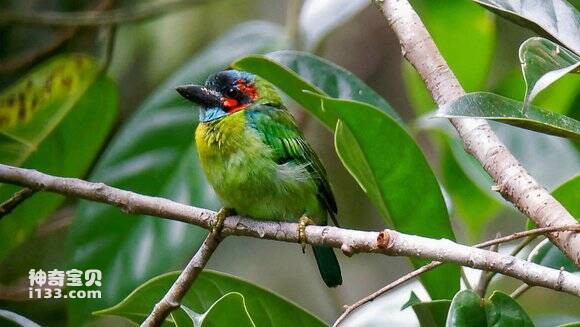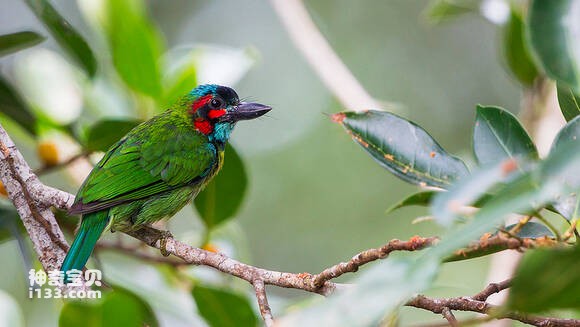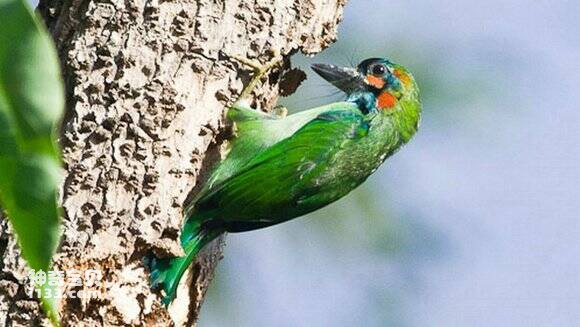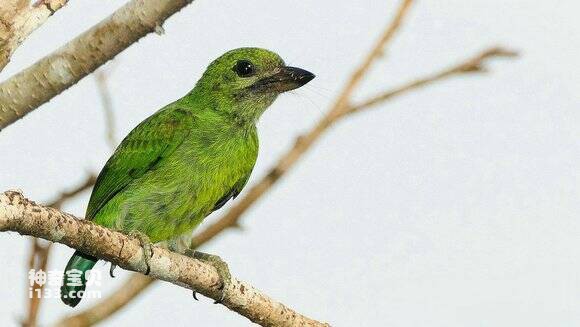Psilopogon cyanotis
IUCN
LCBasic Information
Scientific classification
- name:Psilopogon cyanotis
- Scientific Name:Psilopogon cyanotis,Megalaima australis,Blue-eared Barbet
- Outline:Climbing birds
- Family:
Vital signs
- length:About 17 cm
- Weight:No textual research information is available
- lifetime:No textual research information is available
Feature
It is very similar in appearance to the blue-throated Woodpecker, but smaller in size
Distribution and Habitat
The species is distributed in southwest and southern Yunnan in China. Outside China, it is distributed in India, Myanmar, Thailand, Indochina Peninsula and Indonesia.
The blue-eared woodpecker mainly inhabits tall trees in the low hills and the plain at the foot of the mountains. During the breeding period, it mostly inhabits dense forests, and during the non-breeding period, it also appears on trees near the forest edge, bamboo forest, village edge and farmland.
Appearance
The plumage is white on the base of the upper bill and nostrils, and forms a narrow white band at the base of the forehead. The forehead and the front of the head are black, the forehead is blue, the back of the head is blue; The back pillow turns dark green. Back, shoulders, surface of wings, waist, tail covering and tail grass green. Blue on the tail. Primary feathers are black with green and ochre white spots. The eyes are first mixed with blue and black; Ear cover blue. Its upper and lower each have a blood-red spot; There is also a red spot under the eye. Chin, throat blue, there is a black longitudinal spot between chin and cheek; There is a thin black band between the throat and the chest. The chest, abdomen and the rest of the lower body light grass green, some tail lower surface decorated with blue.
The blue-eared woodpecker baby is blue on top of its head. Others resemble adult birds.
The irises of the blue-eared woodpecker are dark brown or reddish-brown, the corners o
Details
The Blue-eared woodpecker is known as Psilopogon cyanotis, Megalaima australis, and Blue-eared Barbet, with 7 subspecies (1. Named subspecies: Psilopogon cyanotis australis. 2. Yunnan subspecies: Psilopogon cyanotis cyanotis. 3. Malay subspecies: Psilopogon cyanotis duvaucelii. 4. Psilopogon cyanotis gigantorhina, Sumatran subspecies. 5. Southeast Asian subspecies: Psilopogon cyanotis orientalis. 6. Psilopogon cyanotis tanamassae, Batu subspecies. 7 Burmese subspecies of Woodpecker: Psilopogon cyanotis stuarti.) . The blue-eared woodpecker often acts alone or in pairs. When resting, it lives on the horizontal branches at the top of tall trees, and makes rough calls constantly. The vocalizations are varied and rapid, but they are almost non-vocal in winter. It mainly feeds on plant fruits and seeds, but also eats some insects and insect larvae.

The breeding period of the blue-eared Woodpecker is from April to June. They usually nest in the evergreen broad-leaved forest at the foot of the mountain below 1000 meters above sea level, and sometimes they also dig holes in the trees at the edge of the forest and the ground. Each clutch lays 2-4 eggs. The second and third eggs are usually laid 3-4 days apart. The shape of the egg is oblong or oblong. The color is white, the size is 22-27×17-20 mm, and the eggs are incubated by male and female in turn. Both male and female birds live in nest holes at night. Young birds are late sex.

The blue-eared woodpecker population is extremely rare。

It was included in the List of Beneficial Terrestrial Wildlife under State Protection or of Important economic and scientific research Value issued by the State Forestry Administration of China on August 1, 2000.
Listed on the IUCN Red List of Threatened Species (IUCN 2016 ver 3.1) - Not at Risk (LC)
。

Protect wild animals and eliminate wild meat.
Maintaining ecological balance is everyone's responsibility!








